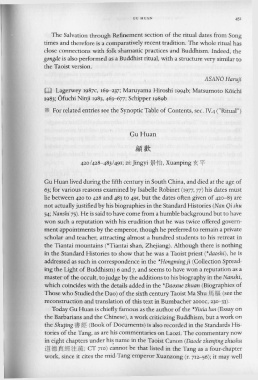Page 491 - The Encyclopedia of Taoism v1_A-L
P. 491
GU H UAN 451
The Salvation through Refinement section of the ritual dates from Song
times and therefore is a comparatively recent tradition. The whole ritual has
close connections with folk shamanic practices and Buddhism. Indeed, the
gongde is also performed as a Buddhist ritual, with a structure very similar to
the Taoist version.
ASANO Haruji
III Lagerwey 1987C, 169-237; Maruyama Hiroshi 1994b; Matsumoto K6ichi
1983; Ofuchi Ninji 1983, 463-677; Schipper I989b
:>.<: For related entries see the Synoptic Table of Contents, sec. IV4 ("Ritual")
GuHuan
420 /428-483 /491; zi: ]ingyi ~ '~~ , Xuanping K ~
Gu Huan lived during the fifth century in South China, and died at the age of
63; for various reasons examined by Isabelle Robinet (I977, 77) his dates must
lie between 420 to 428 and 483 to 49I, but the dates often given of 420- 83 are
not actually justified by his biographies in the Standard Histories (Nan Qi shu
54; Nanshi 75). He is said to have come from a humble background but to have
won such a reputation with his erudition that he was twice offered govern-
ment appointments by the emperor, though he preferred to remain a private
scholar and teacher, attracting almost a hundred students to his retreat in
the Tiantai mountains (*Tiantai shan, Zhejiang). Although there is nothing
in the Standard Histories to show that he was a Taoist priest (*daoshi), he is
addressed as such in correspondence in the *Hongmingji (Collection Spread-
ing the Light of Buddhism) 6 and 7, and seems to have won a reputation as a
master of the occult, to judge by the additions to his biography in the Nanshi,
which coincides with the details added in the *Daoxue zhuan (Biographies of
Those who Studied the Dao) of the sixth century Taoist Ma Shu ,1R§;tW! (see the
reconstruction and translation of this text in Bumbacher 2000C, 230-33)·
Today Gu Huan is chiefly famous as the author of the *Yixia lun (Essay on
the Barbarians and the Chinese), a work criticizing Buddhism, but a work on
the Shujing ~~ (Book of Documents) is also recorded in the Standards His-
tories of the Tang, as are his commentaries on Laozi. The commentary now
in eight chapters under hi~ name in the Taoist Canon (Daode zhenjing zhushu
J1!1!8n~;~~Y!iBfE ; CT 7ID) cannot be that listed in the Tang as a four-chapter
work, since it cites the mid-Tang emperor Xuanzong (r. 7I2-56); it may well

